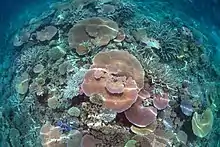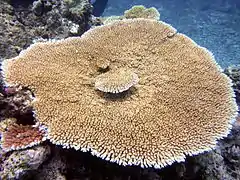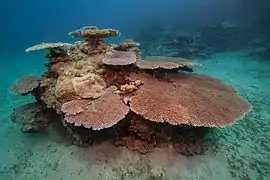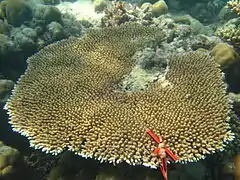Acropora hyacinthus
Acropora hyacinthus is a species of acroporid coral found from the Indian Ocean, the Indo-Pacific waters, southeast Asia, Japan, the East China Sea and the western Pacific Ocean. It lives on shallow reefs on upper reef slopes, and is found from depths of 1–25 m. Crown-of-thorns starfish preferentially prey upon Acropora corals. It was described by Nemenzo in 1971.
| Acropora hyacinthus | |
|---|---|
 | |
| Lodestone Reef, Queensland | |
| Scientific classification | |
| Kingdom: | Animalia |
| Phylum: | Cnidaria |
| Class: | Anthozoa |
| Order: | Scleractinia |
| Family: | Acroporidae |
| Genus: | Acropora |
| Species: | A. hyacinthus |
| Binomial name | |
| Acropora hyacinthus (Dana, 1846) | |
| Synonyms | |
|
List
| |
Description
Acropora hyacinthus occurs in plate- or table-shaped wide colonies that consist of a number of thin branches in a lattice structure. It has strongly inclined branchlets. This pale species contains incipient axial and axial corallites that cannot be distinguished, and its branchlets contain cup-shaped radial corallites. All corallites on specimens of Acropora hyacinthus are darker than the main branch structure. The species looks similar to Acropora cytherea.[2]
Growth rate
Branching corals of the genus Acropora are among the fastest-growing taxa on most coral reefs.
A. hyacinthus, average growth rates range from \3 to 10 cm diameter increase per year, with much of this variation thought to be a response to temperature, in addition to competition and other abiotic and biotic factors (Tomascik et al. 1996; Wakeford et al. 2008;Linares et al. 2011).
Distribution
Acropora hyacinthus is classed as a data deficient species on the IUCN Red List, but it is believed that its population is decreasing in line with the global decline in reefs, and it is listed under Appendix II of CITES. Figures of its population are unknown, but is likely to be threatened by the global reduction of coral reefs, the increase of temperature causing coral bleaching, climate change, human activity, the crown-of-thorns starfish (Acanthaster planci) and disease.[1] It occurs at depths from 1 to 25 metres (3 ft 3 in to 82 ft 0 in) on the upper slopes of shallow reefs. It occurs in the Indian Ocean, the Indo-Pacific waters, southeast Asia, Japan, the East China Sea, Australia, and the western Pacific Ocean.[1]
Taxonomy
The species was originally described by James Dwight Dana in 1846 as Madrepora hyacinthus.[3]
References
- Aeby, G.; Delbeek, J.T.; Lovell, E.R.; Richards, Z.T.; Reboton, C. & Bass, D. (2014). "Acropora bifurcata". IUCN Red List of Threatened Species. 2014: e.T133658A54302913. doi:10.2305/IUCN.UK.2014-1.RLTS.T133658A54302913.en. Retrieved 5 January 2018.
- "Acropora bifurcata". Australian Institute of Marine Species. Retrieved 14 August 2015.
- "Acropora hyacinthus (Dana, 1846)". World Register of Marine Species. Retrieved 5 September 2018.
| Wikimedia Commons has media related to Acropora hyacinthus. |



